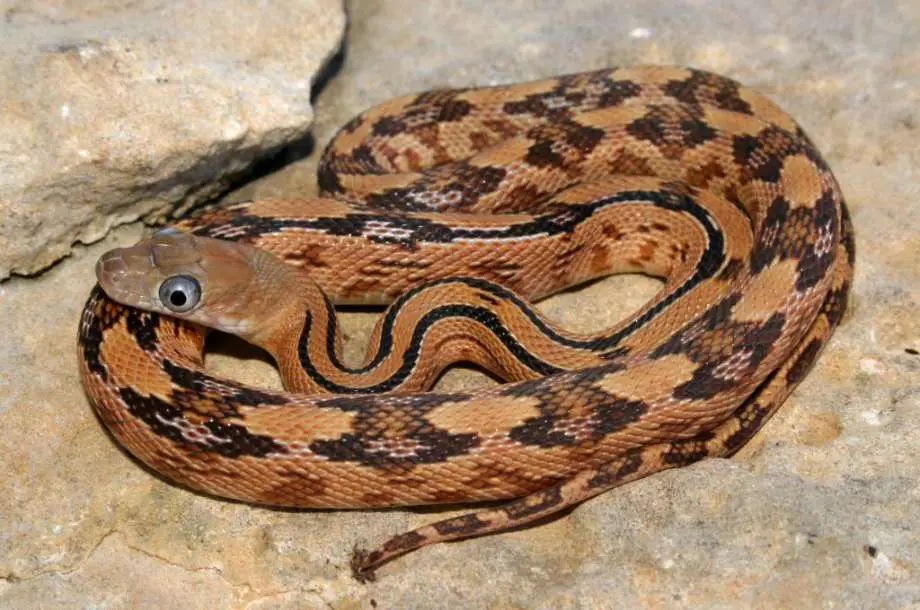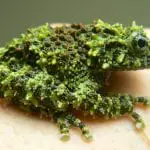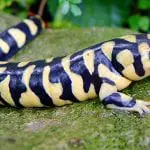Scientific Facts
| Common Name: | Trans-Pecos Rat Snake, Coiled Rat Snake, Davis Mountain Rat Snake |
| Scientific Name: | Bogertophis Subocularis |
| Life Span: | 12 to 20 years |
| Length: | About 6 feet |
| Clutch Size: | 4 to 12 |
| Habitat: | Bushy areas, desert, rock piles |
Physical Description
Trans-Pecos Rat Snakes are quite popular in the United States. They have huge, slightly protruding eyes. They also have a distinct pattern, which is consists of a series of dark and H-shaped blotches visible on the dorsum. They are also known for their docile demeanor. This species is known for its blotches, stripes, or a combination of both. There are even species that are uncolored. There are varieties that are referred to as a melanistic, which means that they lack black pigment, or leucistic, meaning they have white coloration with blue eyes.
These snakes usually reach a size of 76 to 140 cm in length, though occasionally, they reach a length that exceeds 165 cm. The color of the background usually varies depending on the population. For snakes that are found in the Stockton Plateau areas, they are a light tan. This is in contrast to snakes that are usually found in dark igneous rock formations of Far Western Texas, displaying either an orange or bright yellow background.
Another physical characteristic of the Trans-Pecos Rat Snake is the presence of small lines of scales that separate their huge rounded eyes from their upper lip scales. These scales give these snakes a “bug-eyed” look.
Distribution and Range
These snakes are usually found in the Mexican States of Coahuila, Chihuahua, Nuevo Leon, and Durango. Its overall range also extends to the North into New Mexico and Texas. The habitat of these snakes includes brushy slopes and desert flats, as well as rocky outcrops where they usually den.
These snakes are typically associated with the rocky Chihuahuan Desert areas, even though they have also been recorded from the Davis Mountains and the oak-juniper woodlands of Big Bend.
Behavior
Trans-Pecos Rat Snakes are generally non-venomous. They usually kill their prey by constriction. In certain instances, which are very rare, they end up defending themselves from humans by means of biting.
Their large, steel-colored, or blue-grey eyes suggest that they have nocturnal hunting habits. This means that they do most of their hunting and eating at night. They are typically seen at night crossing roads during the warmer months of June to August. They usually retreat and hide to limestone cracks and crevices during the day.
Just like other reptiles that live in areas with temperate climates, these snakes usually go through a period of inactivity during the coolest months of the year. This allows sexually mature Trans-Pecos Rat adult snakes to generate the eggs and sperm needed for successful reproduction around summertime.
Being nocturnal, these snakes are quite uncommon and are seen rarely in the wild. They are even called “suboc” by some enthusiasts and are non-aggressive when approached. They are even passive most of the time, making them one of the easiest to raise in captivity.
It is a myth that most snakes burn themselves by directly lying on hot glass beneath their substrate. Even though this is something only heard of, it has been observed that proper cage temperatures and adequate hides eliminate the need to burrow down to the glass of the cage.
Reproduction
Just like other harmless snakes, Trans-Pecos Rat Snakes are egg-laying creatures. Mating of the Trans-Pecos Rat Snakes usually happens in the spring and early summer, usually with 4 to 12 eggs laid shortly afterward. The actual clutch size depends on the age and size of the female.
The eggs are usually larger and elongated in shape. At times the shape just below 3 inches in length. The permeable and soft eggs are usually buried deep beneath the debris, holding the humidity level at an appropriate rate in order to prevent desiccation. The hatchlings are usually 27 to 36 cm, which usually has paler marks compared with their adult counterparts.
The neonates usually hatch from eggs about two months after their deposition. After hatching, these delicate young snakes look like the adults in appearance except that they are typically paler. Just like other snake species, they need no care or assistance from their parents as they are well-capable of defending themselves right from birth.
How to Care
Even though they are not really related to the more common rat snake varieties, the basic care of these Trans-Pecos rat snakes is somewhat similar to that of other commonly cared species. The care of this species starts with making sure that your snakes are housed properly, fed right, and identified accordingly, not to mention the need to make sure that you have accurately gendered male and female snakes.
Enclosure
Good caging and appropriate maintenance practices are necessary for making sure that your captive snakes are prepared for reproduction. Trans-Pecos rat snakes need enclosure conditions which may be different from other rat snake varieties. In fact, even though the general maintenance is quite similar, it is not safe to assume that the cage conditions should be similar to the climate in the deserts from which they came from.
This is mainly because humans generally think that deserts are arid and harsh regions. However, at night, which is the time when most of the snakes are active, the conditions may be different. As they are nocturnal, Trans-Pecos rat snakes require shelter from the light and heat of the day. In order to do so, they dig holes during warmer days in underground cave settings, where it is usually less arid and cooler.
Very important for the success of captive care of Trans-Pecos rat snakes is making sure that they are provided enough ventilation. In most cages that are aquarium type, wire or nylon mesh lids are a good means of ventilation.
While it is almost impossible to maintain the cage temperature and humidity in cages that use screen sides, the use of complete screen closures is recommended. Even though cross-ventilation coming from the opposing walls of the cage would prove to be more efficient, these snakes in captivity often injure their rostrums seriously as they attempt to escape through the mesh panels located on the cage sides.
Make sure to avoid constricting ventilation through its screen top. Trans-Pecos rat snakes do not really do well in too humid environments. If the room in which they are kept has high levels of ambient humidity, it is often recommended to use a particulate wood pulp as substrate, like Aspen beddings, as it is effective in wicking ambient moisture away out of the air space inside the cage.
If your snake experiences digestion or feeding problems, or show some obvious signs of breathing issues, which is typically evidenced by the gaping of their mouth, the common reason for such a problem is excessive ambient humidity inside their cage.
Male Trans-Pecos rat snakes can deplete their sperm stores seriously if always in contact with hot surfaces for extended periods of time. As such, if you notice that your snakes are prone to burrowing, it may be because the depth of the substrate is too deep, thus preventing enough amount of heat from rising to the surface of the substrate.
Generally, all snakes have the ability to burrow; though evidenced by the construct and shape of the head of Trans-Pecos rat snakes, burrowing is not a usual practice for them. They will only resort to burrowing if their cage requirements are not met, including proper temperature at the surface of the substrate, and the presence of adequate hide.
Temperature
Trans-Pecos Rat Snakes came from desert areas, as well as other arid habitats. Even though they are generally hardy, they are quite prone to some fungal skin diseases, especially when they are kept in damp locations. When their cage is ventilated poorly, there is a tendency that these snakes become prone to respiratory problems.
With this in mind, it is recommended to keep your snake inside a terrarium that has a screen cover. If you opt to use plastic containers in order to raise your hatchlings, make sure that it has a few air-holes. Cross-ventilating holes also need to be drilled. Otherwise, your snakes may not survive.
The ideal temperature inside the cage of Trans-Pecos rat snakes ranges from 82 to 85 degrees Fahrenheit on the warmer side, and around 70 to 81 degrees on the cooler side. This is achieved typically by heating an end of the cage using an under tank device, without any heat source on the other end.
It is also recommended to place two or three hides inside the cage, which are slightly larger compared with the snake. Most of the snakes are not attracted normally to the presence of cavernous hides. In fact, even zones that are properly temperature are often only used by the snakes if the areas are a good place to hide. Since they are nocturnal snakes, with no eyelids, they avoid resting in open spaces instinctively.
Shedding
The process of shedding among Trans-Pecos Rat Snakes usually takes 8 to 10 days. Within this period, it is generally safe to increase the ambient humidity inside the cage by slightly dampening the substrate that is present around the warmer part of the hide every day. Avoid dampening the substrate to the point of fostering bacterial or fungal growth.
During shedding, appropriate dampening of the hide helps the snakes in remaining hydrated metabolically during the longer days when most of them feel reluctant to leave their hiding places to drink water. Thus, it is encouraged to mimic the semi-humid condition of the hides in their natural crevices and cages, but avoid having a dampened substrate unattended for several days.
The use of under tank heating is also advised since other devices for heating can dehydrate the air space inside the cage unsafely. Moderation in everything will result in better conditions inside the cage of your pets.
How to Choose the Right Trans-Pecos Rat Snakes
Just like most serpents, Trans-Pecos Rat Snakes can be quite challenging to care for, especially for inexperienced snake keepers. Maturity and as such, size vary from one species to another. However, in general, Trans-Pecos Rat Snakes are considered mature sexually when they already reach 36 inches in length. Still, there have been reports of males that were just 30 inches in length, with a weight of around 225 grams, but was able to sire successfully. However, females that are smaller than 250 grams seldom accept advances coming from male snakes.
Snake keepers do not recommend breeding a female that is lower than 300 grams in weight because this could result in difficulties in laying eggs, even fatal for some. It is seldom that age affects their sexual maturity. Regardless, maturity is achieved sexually in 2 to 3 years, depending on genetics, cage conditions, and feeding patterns.
Conservation Status
Trans-Pecos Rat Snakes are not considered as a protected species in certain states. They can be collected legally, provided that you have a hunting license.
At one point, it was thought that this species is the rate. As a matter of fact, it includes were listed under protected species within the state of Texas. However, after completing field research, the dynamics of the population have shown that it is actually common in the right habitat. For this reason, it was removed subsequently from the protected species list of the states.
FAQ Section
How do you identify a Davis Mountain Rat Snake?
The easiest way to tell a rat snake is usually through their scales. They have weakly keeled scales, with some ridges. The snakes’ eyes also reveal that they have round pupils.
Are Davis Mountain Rat Snakes dangerous?
While these snakes are medium to large in size, they are non-venomous. They usually kill by constriction. As such, they pose no threats to humans.
How to take care of Davis Mountain Rat Snake?
The good thing about these snakes is that they are generally docile. As such, their basic care is similar to other commonly kept species.



